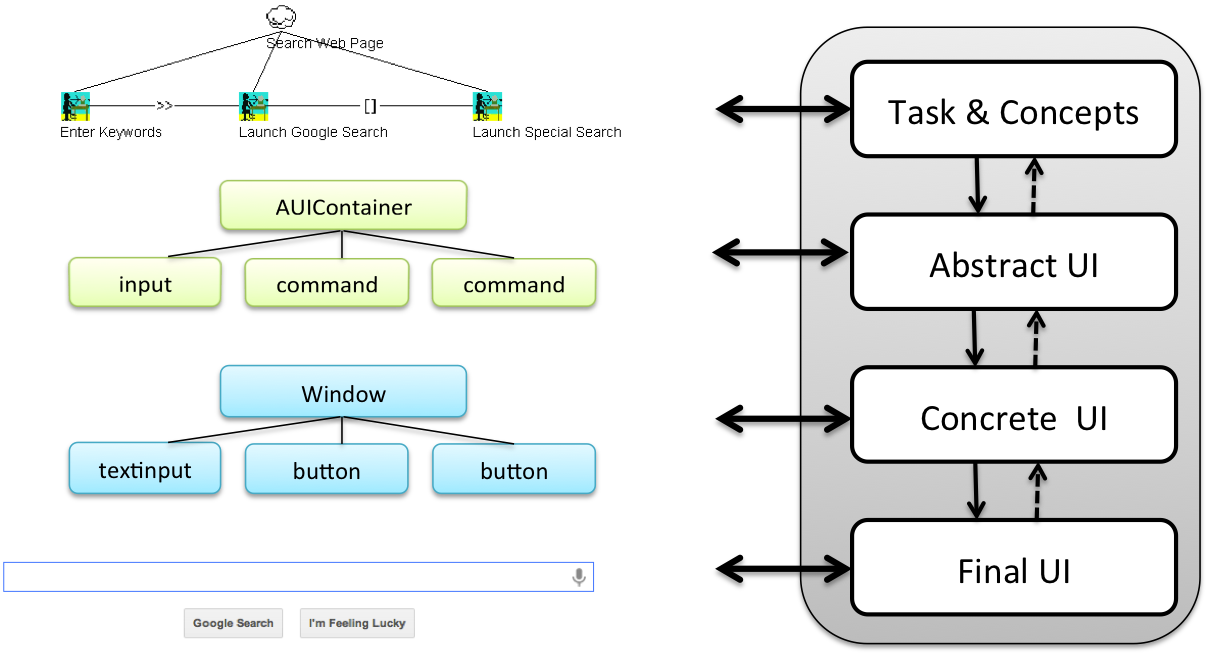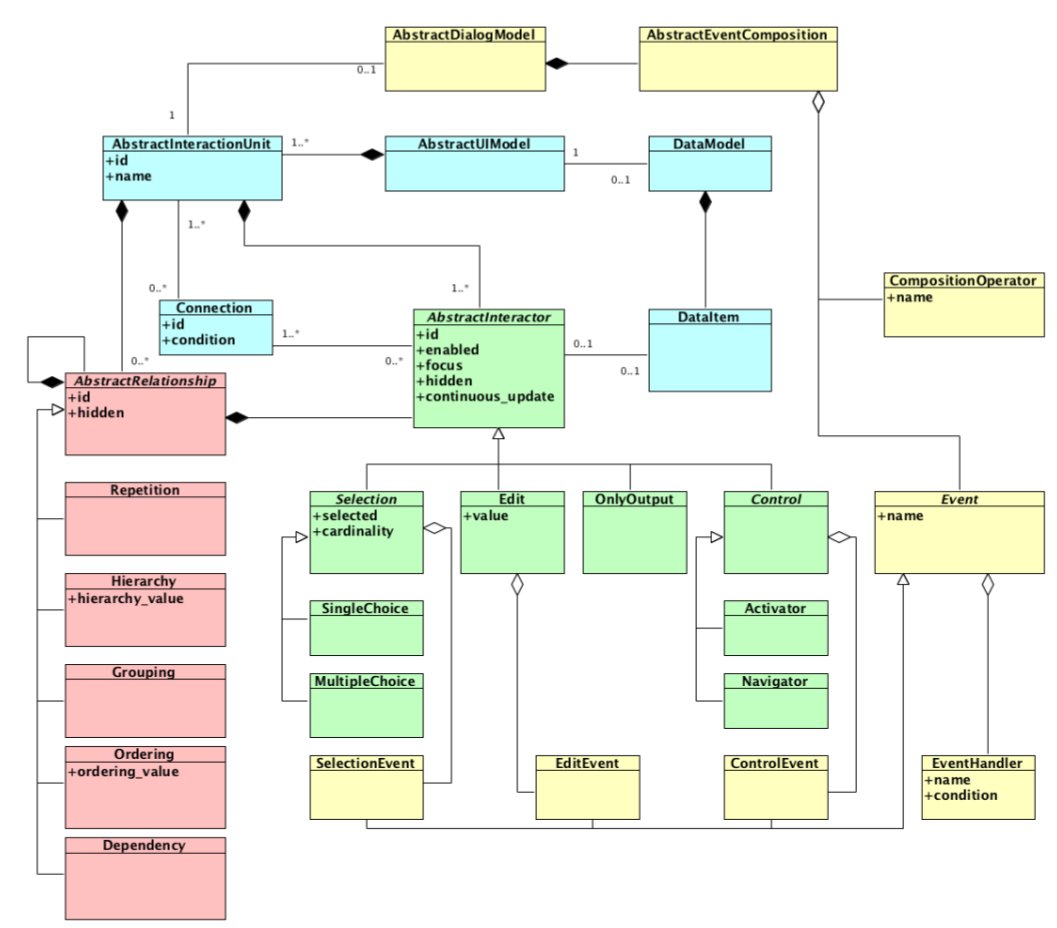3. ASFE-DL Metamodel
This section is normative.
In this section, we describe the first version of the Advanced Service Front-End Description Language (ASFE-DL). This language will enable the development and authoring of service front ends in accordance with the Cameleon Reference Model described in [CAMELEON] and depicted in the following diagram.
 Figure 1: CAMELEON Reference Framework
Figure 1: CAMELEON Reference Framework
In this first version, we focused on the creation of an AUI meta-model, starting from the CNR and UCL experience respectively in MARIA [Paternò2009] and UsiXML [UsiXML]. The idea is to create a unified and more complete language, combining the strengths of the two languages, unifying concepts and adding new features that will allow this language to meet requirements for context aware adaptation of service front ends.
In order to achieve this goal, we analysed the metamodels of both languages. Afterwards, we have identified an initial set of concepts than can represent a first basis for ASFE-DL to be further refined through discussions in the W3C Model-Based UI Working Group. By analyzing the AUI metamodels of MARIA and UsiXML, a number of situations were handled in order to come up with a preliminary shared proposal for the ASFE-DL.
In some cases, there were concepts directly corresponding to each other between metamodels (apart from slightly different names used in the two originated languages). For instance, the original UsiXML elements of types AbstractOrdering, AbstractHierarchy and AbstractRepetition (corresponding to for MARIA’s Ordering, Hierarchy, and Repeater entities) have been basically kept in the this proposal respectively as Ordering, Hierarchy, and Repetition. The same occurred for the UsiXML AbstractRelationship concept, which was easily identified as modelling the same concept as Interactor_composition existing in MARIA language (eventually, we decided to keep the UsiXML naming and to then have the AbstractRelationship element in the ASFE-DL language). Furthermore, both languages support a clear separation of concerns between the UI specification and the description of data handled in it, by including a specific element for handling data: this was called DomainModel in UsiXML and DataModel in Maria (the latter name was eventually selected for the ASFE-DL). However, in other situations, the correspondence between both languages/models was not so direct. For instance, this is the case when the same concept is modelled in a slightly different way, as for the event objects. Indeed, in UsiXML the different types of events are not connected to specific types of interactors, while in MARIA this is the case. Therefore, in the ASFE-DL, we preferred to keep the MARIA approach as it enables a more controlled handling of the specific events associated to each particular type of abstract interactor.
Finally, there were concepts appearing in just one metamodel, which we judged useful to bring in the ASFE-DL. For instance, it was the case of the Connection elements (existing in MARIA language), which allow specifying how it is possible to move from one abstract interaction unit to another one.
 Figure 2: ASFE-DL AUI metamodel (UML View)
Figure 2: ASFE-DL AUI metamodel (UML View)
Figure 2 shows the UML class diagram [UML] for this preliminary version of the ASFE-DL at the abstract level. We used different colours in order to highlight different parts of the metamodel: sky-blue for the main structure of the interface, green for the interactor hierarchy, red for the classes that model the relationships between interactors and yellow for the classes that model the UI behaviour.
The class that represents an abstract user interface model is called AbstractUIModel. It contains the entire specification of both the UI structure and behaviour. The interface contains an optional DataModel, which defines the set of objects and variables. The data model contains all the data types that are manipulated by the UI in order to allow interaction with the user. The composition relation between the DataItem and the DataModel class represents such collection of data types. A DataItem indeed represents a single data type element.
An AbstractUIModel consists of a composition of AbstractInteractionUnits. Each instance of this class represents a part of an application user interface that should be presented to the user at once. Each AbstractInteractionUnit has two attributes: a unique identifier (id attribute) and a name (which is the name of the abstract interaction unit).
An AbstractInteractionUnit is composed of AbstractInteractors and AbstractRelationships. The first one among these AbstractInteractionUnits will be the starting point for interaction.
It is possible to model the navigation among the different abstract interaction units defining instances of the Connection class. A connection (which has a unique identifier, id attribute) specifies the target abstract interaction unit and the interactor (or interactors) that triggers such navigation. It is also possible for the connection to specifiy more than one target interaction unit. In this case, the specification will contain also the condition (see the related attribute in the specification of the Connection element) for the dynamic selection of the target among the specified set of abstract interaction units.
The abstract class AbstractInteractor defines a generic interactor, which represents a generic user interface object. Its subclasses create a partition, which defines a set of different categories according to the interaction semantics. These categories are:
- Selection. This abstract class of interactors represents objects that allow the user to select one or more values from a predefined set of choices. The two refinements SingleChoice and MultipleChoice represent respectively interactors that allow the selection of only one value among the choices, and interactors that allow the selection of more than one value. The UI objects having such a type have a number of attributes: selected, for identifying the selected value; and cardinality, for specifying the cardinality of the value set.
- Edit. This class represents interactors that allow the input of manually edited values. Such an object has the value attribute to identify the currently edited object.
- OnlyOutput. This class represents interactors that show information to the user.
- Control. This abstract class represents interactors that allow the user to perform actions, submit data or navigate the user interface. The refinements Activator and Navigator distinguish the objects mainly devoted to performing actions from the ones to perform UI navigation.
Each AbstractInteractor can be optionally connected to a DataItem, specifying that it represents the referenced data item in the user interface. Each AbstractInteractor has also a number of attributes:
- Grouping: this class represents a generic group of interactors, which share a logical connection
- Ordering: this class represents a set of interactors that have an ordering relation among the elements. There also is the ordering_value attribute, which represents the value for an ordered presentation of the content.
- Hierarchy: this class represents a set of interactors where different levels of importance can be identified. There also is the hierarchy_value attribute, which is used for providing a hierarchical presentation of the content.
- Repetition: this class represents a template for a list of interactors that have to be repeated in order to represent a dynamic list of items, coming from a data source.
- Dependency: A dependency is used when we want to model a dependency relation between 1 interactor/interactor group and other N interactors/interactor groups.
An AbstractRelationship element has a number of attributes:
- Id: the interactor identifier
- Hidden: true if the element is not presented to the user
The AbstractDialogModel class defines the behaviour of the UI. It contains a composition of a set of AbstractEventCompositions, which consist of Events, connected using CompositionOperators. Each CompositionOperator has an identifier, determining the type of composition that can occur on sets of events. Such compositions define the set of events observed by the UI in a given state. Example of event compositions can be e.g. concurrency, sequential enabling, etc. Event is the abstract class that models all abstract asynchronous notifications about the changes on the state of the interactors or user inputs.
To each generic Event, it is possible to associate a list of EventHandlers, which specifies all the actions that have to be performed as a reaction to a certain event. Each EventHandler has its own name, and can be also guarded by a condition, which defines constraints for the reactions.
The generic event class is refined into SelectionEvent, EditEvent and ControlEvent classes:
- The SelectionEvent is associated to the selection abstract interactors and represents the notifications about the change of the selected value (or values) performed by the user.
- The EditEvent notifies the changes performed by the user through the associated edit abstract interactor.
- The ControlEvents notifies the activation of some UI functionalities (e.g. executing some script in a web page), or the switching between presentations, respectively through the activator or navigator abstract UI interactors.
CAMELEON (Context Aware Modelling for Enabling and Leveraging Effective interactiON)
Project (FP5-IST4-2000-30104), http://giove.isti.cnr.it/projects/cameleon.html

